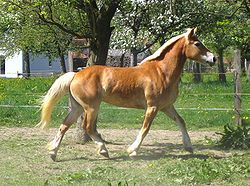This is a list of some of the breeds of horse considered in Germany to be wholly or partly of German origin. In 2014 there were 151 horse breeds reported to DAD-IS by Germany, many of them imported from other parts of the world. Only those breeds with some history of development within present-day Germany are listed below. Inclusion here does not necessarily imply that a breed is predominantly or exclusively German. [1]
| German name | English name if used | Image | Notes |
|---|---|---|---|
| Aegidienberger [1] |  | ||
| Arenberg-Nordkirchner [2] | Arenberg-Nordkirchen | ||
| Alt-Württemberger [1] [2] |  | ||
| Bayerisches Warmblut [1] | Bavarian Warmblood |  | |
| Brandenburger Warmblut [1] | Brandenburger |  | |
| Deutsches Reitpferd [1] | German Riding Horse |  | |
| Deutsches Classic Pony [1] | German Classic Pony |  | |
| Deutsches Part-Bred Shetland Pony [1] | German Part-Bred Shetland Pony |  | |
| Deutsches Pinto Barockpferd [1] | |||
| Deutsches Polopferd [1] | |||
| Deutsches Reitpony [1] | German Riding Pony |  | |
| Deutsches Sportpferd [1] | German Sport Horse |  | |
| Dülmener [1] [2] |  | ||
| Edelbluthaflinger [1] |  | German-bred Haflingers with 1.56% to 25% Arab blood | |
| Hannoveraner Halbblut [1] | |||
| Hannoveraner Warmblut [1] | Hanoverian |  | |
| Hannoversches Kaltblut Schleswiger Ursprungs [1] | Since 2012 a sub-population of the Schleswig Coldblood [3] | ||
| Hessisches Warmblut [1] | Hessian Warmblood |  | Merged with Hanoverian in 2009 |
| Holsteiner Warmblut [1] | Holsteiner |  | |
| Internationales Oldenburger Springpferd [1] | |||
| Kleines Deutsches Pony [1] | |||
| Kleines Deutsches Reitpferd [1] | |||
| Lehmkuhlener [2] | |||
| Leonharder [1] | |||
| Leutstettener [1] [2] | |||
| Lewitzer [1] |  | ||
| Mecklenburger Warmblut [1] | Mecklenburger |  | |
| Oldenburger Warmblut [1] | Oldenburger |  | |
| Ostpreußisches Warmblut Trakehner Abstammung [1] | Trakehner |  | Breeding at the Trakehnen stud ended in October 1944; the present German-language name means roughly "East Prussian Warmblood of Trakehner origin" |
| Pfalz-Ardenner [1] |  | ||
| Rheinisch Deutsches Kaltblut [1] [2] | Rhenish German Coldblood |  | |
| Rheinisches Warmblut [1] | Rhinelander |  | |
| Rottaler [1] [2] |  | ||
| Sachsen-Anhaltiner Warmblut [1] |  | ||
| Sächsisches Warmblut [1] | see Sächsisch-Thüringisches Schweres Warmblut | ||
| Sächsisch-Thüringisches Schweres Warmblut [4] | |||
| Schleswiger Kaltblut [1] [2] | Schleswig Coldblood |  | |
| Schwarzwälder Kaltblut [1] [2] | Black Forest Horse |  | |
| Schweres Warmblut [1] | Heavy warmblood | ||
| Schweres Warmblut / Ostfriesisch-Altoldenburgisch [1] [2] | Ostfriesen and Alt-Oldenburger |  | |
| Senner [1] [2] |  | ||
| Süddeutsches Kaltblut [1] | South German Coldblood |  | |
| Tarpan[ citation needed ] | Heck Horse |  | Was created at Berlin Zoo; it is not reported to DAD-IS, nor listed as endangered by the Gesellschaft zur Erhaltung alter und gefährdeter Haustierrassen |
| Thüringer Warmblut [1] | see Sächsisch-Thüringisches Schweres Warmblut | ||
| Traber [1] | Trotter |  | |
| Warmblut des Zuchtverbandes für deutsche Pferde [1] | |||
| Warmblutschecken [1] | |||
| Westfälisches Warmblut [1] | Westphalian |  | |
| Württemberger Warmblut [1] | Württemberger |  | |
| Zweibrücker Warmblut [1] | Zweibrücker |  | |